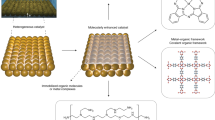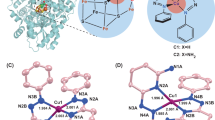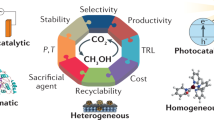Abstract
The electrochemical reduction of CO2 into useful fuels and chemical feedstocks offers great promise for conversion to a carbon-neutral economy. However, challenges in product selectivity continue to limit the practical application of electrocatalytic systems. In this Perspective, we outline the thermodynamic and kinetic factors for the design of improved catalysts for CO2 fixation and carbon–carbon bond formation, and draw parallels between synthetic systems and natural enzymes that perform analogous transformations. By identifying the primary features that underpin the highly efficient CO2 conversion reactions seen in nature, synthetic catalysts can be constructed to take advantage of similar chemical principles. Given the demonstrated prior success of bio-inspired molecular design, increased and dynamic interactions between the chemical, biological and materials science fields will advance catalyst development in a synergistic fashion.

This is a preview of subscription content, access via your institution
Access options
Access Nature and 54 other Nature Portfolio journals
Get Nature+, our best-value online-access subscription
$29.99 / 30 days
cancel any time
Subscribe to this journal
Receive 12 digital issues and online access to articles
$119.00 per year
only $9.92 per issue
Buy this article
- Purchase on Springer Link
- Instant access to full article PDF
Prices may be subject to local taxes which are calculated during checkout



Similar content being viewed by others
References
Faunce, T. A. et al. Energy and environment policy case for a global project on artificial photosynthesis. Energy Environ. Sci. 6, 695–698 (2013).
Lewis, N. S. & Nocera, D. G. Powering the planet: chemical challenges in solar energy utilization. Proc. Natl Acad. Sci. USA 103, 15729–15735 (2006).
Sanz-Pérez, E. S., Murdock, C. R., Didas, S. A. & Jones, C. W. Direct capture of CO2 from ambient air. Chem. Rev. 116, 11840–11876 (2016).
Bushuyev, O. S. et al. What should we make with CO2 and how can we make it? Joule 2, 825–832 (2018).
Scott, A. A big bet on the smallest molecule. C&EN 99, 16–19 (2021).
Cardenas, A. J. P. et al. Controlling proton delivery through catalyst structural dynamics. Angew. Chem. Int. Ed. 55, 13509–13513 (2016).
Cunningham, D. W., Barlow, J. M., Velazquez, R. S. & Yang, J. Y. Reversible and selective CO2 to HCO2− electrocatalysis near the thermodynamic potential. Angew. Chem. Int. Ed. 59, 4443–4447 (2020).
Armstrong, D. A. et al. Standard electrode potentials involving radicals in aqueous solution: inorganic radicals (IUPAC Technical Report). Pure Appl. Chem. 87, 1139–1150 (2015).
Ceballos, B. M. & Yang, J. Y. Directing the reactivity of metal hydrides for selective CO2 reduction. Proc. Natl Acad. Sci. USA 115, 12686–12691 (2018).
Barlow, J. M. & Yang, J. Y. Thermodynamic considerations for optimizing selective CO2 reduction by molecular catalysts. ACS Cent. Sci. 5, 580–588 (2019).
Can, M., Armstrong, F. A. & Ragsdale, S. W. Structure, function, and mechanism of the nickel metalloenzymes, CO dehydrogenase, and acetyl-CoA synthase. Chem. Rev. 114, 4149–4174 (2014).
Hu, Z. et al. Nature of the C-cluster in Ni-containing carbon monoxide dehydrogenases. J. Am. Chem. Soc. 118, 830–845 (1996).
Breglia, R. et al. First-principles calculations on Ni,Fe-containing carbon monoxide dehydrogenases reveal key stereoelectronic features for binding and release of CO2 to/from the C-cluster. Inorg. Chem. 60, 387–402 (2021).
Fesseler, J., Jeoung, J.-H. & Dobbek, H. How the [NiFe4S4] cluster of CO dehydrogenase activates CO2 and NCO−. Angew. Chem. Int. Ed. 54, 8560–8564 (2015).
Eckert, N. A., Dinescu, A., Cundari, T. R. & Holland, P. L. A T-shaped three-coordinate nickel(I) carbonyl complex and the geometric preferences of three-coordinate d9 complexes. Inorg. Chem. 44, 7702–7704 (2005).
Blackaby, W. J. M. et al. Mono- and dinuclear Ni(I) products formed upon bromide abstraction from the Ni(I) ring-expanded NHC complex [Ni(6-Mes)(PPh3)Br]. Dalton Trans. 47, 769–782 (2018).
Amara, P., Mouesca, J.-M., Volbeda, A. & Fontecilla-Camps, J. C. Carbon monoxide dehydrogenase reaction mechanism: a likely case of abnormal CO2 insertion to a Ni−H− bond. Inorg. Chem. 50, 1868–1878 (2011).
Wang, V. C. C., Islam, S. T. A., Can, M., Ragsdale, S. W. & Armstrong, F. A. Investigations by protein film electrochemistry of alternative reactions of nickel-containing carbon monoxide dehydrogenase. J. Phys. Chem. B 119, 13690–13697 (2015).
Keith, J. A., Grice, K. A., Kubiak, C. P. & Carter, E. A. Elucidation of the selectivity of proton-dependent electrocatalytic CO2 reduction by fac-Re(bpy)(CO)3Cl. J. Am. Chem. Soc. 135, 15823–15829 (2013).
Majumdar, A. Bioinorganic modeling chemistry of carbon monoxide dehydrogenases: description of model complexes, current status and possible future scopes. Dalton Trans. 43, 12135–12145 (2014).
Hansen, H. A., Varley, J. B., Peterson, A. A. & Nørskov, J. K. Understanding trends in the electrocatalytic activity of metals and enzymes for CO2 reduction to CO. J. Phys. Chem. Lett. 4, 388–392 (2013).
Isse, A. A., Gennaro, A., Vianello, E. & Floriani, C. Electrochemical reduction of carbon dioxide catalyzed by [CoI(salophen)Li]. J. Mol. Catal. 70, 197–208 (1991).
Bhugun, I., Lexa, D. & Savéant, J.-M. Catalysis of the electrochemical reduction of carbon dioxide by iron(0) porphyrins. Synergistic effect of Lewis acid cations. J. Phys. Chem. 100, 19981–19985 (1996).
Steffey, B. D., Curtis, C. J. & DuBois, D. L. Electrochemical reduction of CO2 catalyzed by a dinuclear palladium complex containing a bridging hexaphosphine ligand: evidence for cooperativity. Organometallics 14, 4937–4943 (1995).
Beley, M., Collin, J. P., Ruppert, R. & Sauvage, J. P. Electrocatalytic reduction of carbon dioxide by nickel cyclam2+ in water: study of the factors affecting the efficiency and the selectivity of the process. J. Am. Chem. Soc. 108, 7461–7467 (1986).
Fujita, E., Creutz, C., Sutin, N. & Brunschwig, B. S. Carbon dioxide activation by cobalt macrocycles: evidence of hydrogen bonding between bound CO2 and the macrocycle in solution. Inorg. Chem. 32, 2657–2662 (1993).
Dey, S., Ahmed, M. E. & Dey, A. Activation of Co(I) state in a cobalt-dithiolato catalyst for selective and efficient CO2 reduction to CO. Inorg. Chem. 57, 5939–5947 (2018).
Costentin, C., Passard, G., Robert, M. & Savéant, J.-M. Pendant acid–base groups in molecular catalysts: H-bond promoters or proton relays? Mechanisms of the conversion of CO2 to CO by electrogenerated iron(0) porphyrins bearing prepositioned phenol functionalities. J. Am. Chem. Soc. 136, 11821–11829 (2014).
Azcarate, I., Costentin, C., Robert, M. & Savéant, J.-M. Through-space charge interaction substituent effects in molecular catalysis leading to the design of the most efficient catalyst of CO2-to-CO electrochemical conversion. J. Am. Chem. Soc. 138, 16639–16644 (2016).
Sung, S., Kumar, D., Gil-Sepulcre, M. & Nippe, M. Electrocatalytic CO2 reduction by imidazolium-functionalized molecular catalysts. J. Am. Chem. Soc. 139, 13993–13996 (2017).
DeLuca, E. E., Xu, Z., Lam, J. & Wolf, M. O. Improved electrocatalytic CO2 reduction with palladium bis(NHC) pincer complexes bearing cationic side chains. Organometallics 34, 1330–1343 (2019).
Murata, A. & Hori, Y. Product selectivity affected by cationic species in electrochemical reduction of CO2 and CO at a Cu electrode. Bull. Chem. Soc. Jpn 64, 123–127 (1991).
Chen, L. D., Urushihara, M., Chan, K. & Nørskov, J. K. Electric field effects in electrochemical CO2 reduction. ACS Catal. 6, 7133–7139 (2016).
Thorson, M. R., Siil, K. I. & Kenis, P. J. A. Effect of cations on the electrochemical conversion of CO2 to CO. J. Electrochem. Soc. 160, F69–F74 (2012).
Liu, M. et al. Enhanced electrocatalytic CO2 reduction via field-induced reagent concentration. Nature 537, 382–386 (2016).
Ogata, H., Nishikawa, K. & Lubitz, W. Hydrogens detected by subatomic resolution protein crystallography in a [NiFe] hydrogenase. Nature 520, 571–574 (2015).
Schneider, C. R., Lewis, L. C. & Shafaat, H. S. The good, the neutral, and the positive: buffer identity impacts CO2 reduction activity by nickel(II) cyclam. Dalton Trans. 48, 15810–15821 (2019).
Zhang, B. A., Ozel, T., Elias, J. S., Costentin, C. & Nocera, D. G. Interplay of homogeneous reactions, mass transport, and kinetics in determining selectivity of the reduction of CO2 on gold electrodes. ACS Cent. Sci. 5, 1097–1105 (2019).
Liu, Y. & McCrory, C. C. L. Modulating the mechanism of electrocatalytic CO2 reduction by cobalt phthalocyanine through polymer coordination and encapsulation. Nat. Commun. 10, 1683 (2019).
Wadsworth, B. L., Khusnutdinova, D. & Moore, G. F. Polymeric coatings for applications in electrocatalytic and photoelectrosynthetic fuel production. J. Mat. Chem. A 6, 21654–21665 (2018).
Sarkar, S., Maitra, A., Banerjee, S., Thoi, V. S. & Dawlaty, J. M. Electric fields at metal–surfactant interfaces: a combined vibrational spectroscopy and capacitance study. J. Phys. Chem. B 124, 1311–1321 (2020).
Banerjee, S., Han, X. & Thoi, V. S. Modulating the electrode–electrolyte interface with cationic surfactants in carbon dioxide reduction. ACS Catal. 9, 5631–5637 (2019).
Quan, F., Xiong, M., Jia, F. & Zhang, L. Efficient electroreduction of CO2 on bulk silver electrode in aqueous solution via the inhibition of hydrogen evolution. Appl. Surf. Sci. 399, 48–54 (2017).
Barlow, J. M., Ziller, J. W. & Yang, J Y. Inhibiting the hydrogen evolution reaction (HER) with proximal cations: a strategy for promoting selective electrocatalytic reduction. ACS Catal. 11, 8155–8164 (2021).
Maia, L. B., Moura, I. & Moura, J. J. G. Molybdenum and tungsten-containing formate dehydrogenases: aiming to inspire a catalyst for carbon dioxide utilization. Inorg. Chim. Acta 455, 350–363 (2017).
Niks, D., Duvvuru, J., Escalona, M. & Hille, R. Spectroscopic and kinetic properties of the molybdenum-containing, NAD+-dependent formate dehydrogenase from Ralstonia eutropha. J. Biol. Chem. 291, 1162–1174 (2016).
Appel, A. M. et al. Frontiers, opportunities, and challenges in biochemical and chemical catalysis of CO2 fixation. Chem. Rev. 113, 6621–6658 (2013).
Bassegoda, A., Madden, C., Wakerley, D. W., Reisner, E. & Hirst, J. Reversible interconversion of CO2 and formate by a molybdenum-containing formate dehydrogenase. J. Am. Chem. Soc. 136, 15473–15476 (2014).
Yang, J. Y., Kerr, T. A., Wang, X. S. & Barlow, J. M. Reducing CO2 to HCO2– at mild potentials: lessons from formate dehydrogenase. J. Am. Chem. Soc. 142, 19438–19445 (2020).
Forster, D. On the mechanism of a rhodium-complex-catalyzed carbonylation of methanol to acetic acid. J. Am. Chem. Soc. 98, 846–848 (1976).
Gencic, S. & Grahame, D. A. Two separate one-electron steps in the reductive activation of the A cluster in subunit β of the ACDS complex in Methanosarcina thermophila. Biochemistry 47, 5544–5555 (2008).
Dougherty, W. G., Rangan, K., O’Hagan, M. J., Yap, G. P. A. & Riordan, C. G. Binuclear complexes containing a methylnickel moiety: relevance to organonickel intermediates in acetyl coenzyme A synthase catalysis. J. Am. Chem. Soc. 130, 13510–13511 (2008).
Matsumoto, T., Ito, M., Kotera, M. & Tatsumi, K. A dinuclear nickel complex modeling of the Nid(II)–Nip(I) state of the active site of acetyl CoA synthase. Dalton Trans. 39, 2995–2997 (2010).
Manesis, A. C. et al. A biochemical nickel(I) state supports nucleophilic alkyl addition: a roadmap for methyl reactivity in acetyl coenzyme A synthase. Inorg. Chem. 58, 8969–8982 (2019).
Manesis, A. C., O’Connor, M. J., Schneider, C. R. & Shafaat, H. S. Multielectron chemistry within a model nickel metalloprotein: mechanistic implications for acetyl-CoA synthase. J. Am. Chem. Soc. 139, 10328–10338 (2017).
Kisgeropoulos, E. C., Manesis, A. C. & Shafaat, H. S. Ligand field inversion as a mechanism to gate bioorganometallic reactivity: investigating a biochemical model of acetyl CoA synthase using spectroscopy and computation. J. Am. Chem. Soc. 143, 849–867 (2021).
Kampa, M., Pandelia, M.-E., Lubitz, W., van Gastel, M. & Neese, F. A metal–metal bond in the light-induced state of [NiFe] hydrogenases with relevance to hydrogen evolution. J. Am. Chem. Soc. 135, 3915–3925 (2013).
Huynh, M. T., Schilter, D., Hammes-Schiffer, S. & Rauchfuss, T. B. Protonation of nickel–iron hydrogenase models proceeds after isomerization at nickel. J. Am. Chem. Soc. 136, 12385–12395 (2014).
Manesis, A. C. & Shafaat, H. S. Electrochemical, spectroscopic, and density functional theory characterization of redox activity in nickel-substituted azurin: a model for acetyl-CoA synthase. Inorg. Chem. 54, 7959–7967 (2015).
Xing, Z., Hu, X. & Feng, X. Tuning the microenvironment in gas-diffusion electrodes enables high-rate CO2 electrolysis to formate. ACS Energy Lett. 6, 1694–1702 (2021).
Morales-Guio, C. G. et al. Improved CO2 reduction activity towards C2+ alcohols on a tandem gold on copper electrocatalyst. Nat. Catal. 1, 764–771 (2018).
Lum, Y. & Ager, J. W. Sequential catalysis controls selectivity in electrochemical CO2 reduction on Cu. Energy Environ. Sci. 11, 2935–2944 (2018).
Huff, C. A. & Sanford, M. S. Cascade catalysis for the homogeneous hydrogenation of CO2 to methanol. J. Am. Chem. Soc. 133, 18122–18125 (2011).
Chu, W.-Y., Culakova, Z., Wang, B. T. & Goldberg, K. I. Acid-assisted hydrogenation of CO2 to methanol in a homogeneous catalytic cascade system. ACS Catal. 9, 9317–9326 (2019).
Megarity, C. F. et al. Electrocatalytic volleyball: rapid nanoconfined nicotinamide cycling for organic synthesis in electrode pores. Angew. Chem. Int. Ed. 58, 4948–4952 (2019).
Marcandalli, G., Villalba, M. & Koper, M. T. M. The importance of acid–base equilibria in bicarbonate electrolytes for CO2 electrochemical reduction and CO reoxidation studied on Au(hkl) electrodes. Langmuir 37, 5707–5716 (2021).
Acknowledgements
H.S.S. acknowledges the US Department of Energy, award DE-SC0018020, for supporting research that informed this perspective. J.Y.Y. acknowledges the US Department of Energy, award DE-SC0020275, and the National Science Foundation, award CHE-2102589, for supporting research that informed this Perspective.
Author information
Authors and Affiliations
Corresponding authors
Ethics declarations
Competing interests
The authors declare no competing interests.
Additional information
Peer review information Nature Catalysis thanks the anonymous reviewers for their contribution to the peer review of this work.
Publisher’s note Springer Nature remains neutral with regard to jurisdictional claims in published maps and institutional affiliations.
Rights and permissions
About this article
Cite this article
Shafaat, H.S., Yang, J.Y. Uniting biological and chemical strategies for selective CO2 reduction. Nat Catal 4, 928–933 (2021). https://doi.org/10.1038/s41929-021-00683-1
Received:
Accepted:
Published:
Issue Date:
DOI: https://doi.org/10.1038/s41929-021-00683-1
This article is cited by
-
The origins of catalytic selectivity for the electrochemical conversion of carbon dioxide to methanol
Nano Research (2024)
-
Bioinspired photocatalytic systems towards compartmentalized artificial photosynthesis
Communications Chemistry (2023)
-
Selective CO2 electrolysis to CO using isolated antimony alloyed copper
Nature Communications (2023)
-
Energy-efficient CO2/CO interconversion by homogeneous copper-based molecular catalysts
Nature Communications (2023)
-
Carbon dioxide electroreduction into formic acid and ethylene: a review
Environmental Chemistry Letters (2022)



